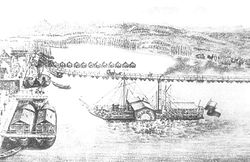City of Mainz (ship)
|
The city of Mainz in the harbor
|
||||||||||||||||||||||||||||||
|
||||||||||||||||||||||||||||||
|
||||||||||||||||||||||||||||||
|
||||||||||||||||||||||||||||||
|
||||||||||||||||||||||||||||||
The city of Mainz was a wooden paddle steamer and the first steamship to be built in a Rhenish shipyard .
construction
The ship was built as a smooth decker for the transport of people and goods and designed by Strack, Kriens and Harvey. It was built at the Ruhrort shipyard Jacobi, Haniel & Huyssen by former employees Gerhard Moritz Roentgens , Ing.Harvey and Wilhelm Strack and the shipbuilder Kriens from Ruhrort. It was launched on May 7, 1830, and handed over to the Prussian-Rhenish Steamship Company (PRDG) on October 19, 1830.
Drive data
- Drive: single-cylinder medium-pressure steam engine with flywheel, 75 hp, from 1832 90 hp.
- Flame tube drum boiler with 65.8 m² heating surface and 0.6 kp / cm² steam pressure
- Bucket wheels made of wood: 5.80 m diameter with 19 buckets
Division of the trunk
The hull was divided into a sailor's apartment in the bow , followed by a small cabin and, behind it, to starboard, the captain's cabin with opposite toilet and stairs to deck. Amidships were the boiler room and engine room and in the stern a large cabin 7.93 m long, as well as two toilets and a staircase to the deck. The main deck in front was intended for people and goods and was equipped with a mast with a cargo boom. A companionway led to the sailors' apartment.
history
The ship was christened on May 7, 1830 when the ship was launched. The first test drive was from Ruhrort to Düsseldorf on October 13, 1830 , and a day later a festive test drive with Prince Friedrich of Prussia , the district president Philipp von Pestel and other celebrities. During the last test drive on October 19, it was to be handed over to the PRDG, as it turned out during the first drives that the required steam pressure was not achieved. At the beginning of 1831 changes were made to the machine and a test drive was made in May. The PRDG again refused acceptance because the single-cylinder steam engine was not running smoothly. In the summer of 1831 the city of Mainz made the first attempts at towing on the Lower Rhine .
In the spring of 1832, the shipyard began converting the ship. A two-cylinder low-pressure machine with 76 PSn (260 PSi) and a suitcase boiler with 72 m² heating surface were installed. The chimney was installed directly above the boiler, the drive shafts moved further back and new paddle wheels with twelve blades and 4.78 m in diameter were added. The wheel arches have been redesigned. After a successful test drive on August 17, 1832, the PRDG took over the city of Mainz on August 23 . In the years that followed, he stayed at the shipyard for longer periods of time, with the boiler being replaced in 1833, and in 1834 the hull was lengthened and reinforced with iron parts and the hull was partially clad with sheet iron.
commitment
In 1840 the city of Mainz was sold to the GHH for 15,000 Thaler . After the entire hull was covered with sheet iron, the Nederlandsche Stoomboot Maatschappij (NSBM) took over the ship without an engine and, after installing a new engine, used it on the Rotterdam - Antwerp route under the name Schelde . In 1847 it was resold to NV Zierikzeesche Stoomboot Matschappij F. Kloos & Zoon and was renamed Stad Zierikzee . In 1877 the Quakernaat van Spijk shipping company bought the ship and used it on the Gorinchem - Rotterdam route under the name Gorinchem . In 1878 it was sold to a scrapping yard.
literature
- Georg Fischbach: The ships of the KD (a detailed list on over 1000 pages with many historical and current photos of all ships of the KD from 1826 to 2005). Publisher: Self-published, available from KD Cologne.
- Hans Rindt, The ships of the Cologne-Düsseldorfer then and now , publisher Gunter Dexheimer

